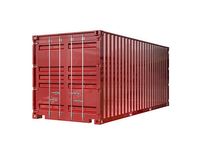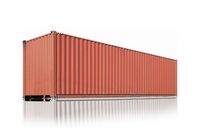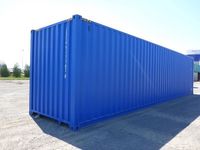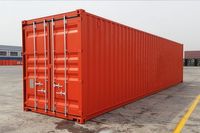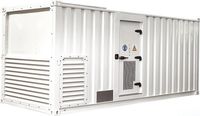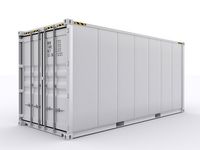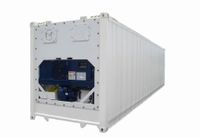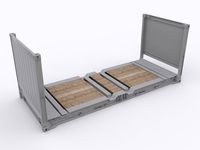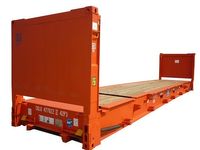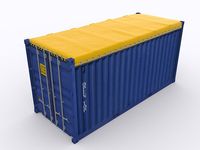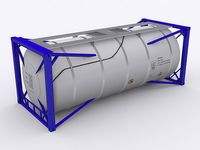We would like to inform you through the different ocean container types and their shipping container dimensions including:
- 20 ft dry shipping container
- 40 ft dry shipping container
- 40 ft dry high cube shipping container
- 45 ft dry high cube shipping container
- 20 ft flat rack shipping container
- 40 ft flat rack shipping container
- 20 ft open top shipping container
- 40 ft open top shipping container
- 20 ft ventilated shipping container
- 20 ft refrigerated shipping container
- 40 ft refrigerated shipping container
- 20 ft tank shipping container
Standard shipping container dimensions
The 20 ft standard shipping container and the 40 ft standard shipping container are two of the most widely used containers in the world to transport ocean freight goods.
The standard shipping containers differ from other types of containers in that they are completely airtight. These hermetically sealed shipping containers are not equipped with cooling nor ventilation systems like the refrigerated and ventilated containers.
The 20 ft standard shipping container can hold up to 10 standard pallets or 11 Euro pallets across its floor base.
The standard shipping containers are also known as dry shipping containers or dry vans.
20 ft standard shipping container dimensions
Container Reference Code: | 22GP |
Container Application: | The 20 ft standard shipping container is for general purpose cargo. | ||
Container Dimensions: | Width | Height | Length |
Door opening in feet | 7' 8 ⅛" | 7' 6 ¼" | |
Door opening in meters | 2.34 m | 2.29 m | |
Interior dimensions in feet | 7' 8 ⅝" | 7' 6 ¼" | 19' 4 ¼" |
Interior dimensions in meters | 2.34 m | 2.29 m | 5.9 m |
Container Weight | Max Gross | Tare | Max Payload |
Weight in lbs | 52,831 lbs | 4,914 lbs | 47,899 lbs |
Weight in kg | 23,956 kg | 2,229 kg | 21,727 kg |
Container Volume | In CFT | In CBM | |
Load Capacity | 1,172 CFT | 33.2 CBM |
40 ft standard shipping container dimensions
Container Reference Code: | 42GP |
Container Application: | The 40 ft standard shipping container is for general purpose cargo. | ||
Container Dimensions: | Width | Height | Length |
Door opening in feet | 7' 8 ⅛" | 7' 6 ¼" | |
Door opening in meters | 2.34 m | 2.29 m | |
Interior dimensions in feet | 7' 8 ⅝" | 7' 10 ¼" | 37' 11 ¼" |
Interior dimensions in meters | 2.352 m | 2.395 m | 12.01 m |
Container Weight | Max Gross | Tare | Max Payload |
Weight in lbs | 67,199 lbs | 5,220 lbs | 59,039 lbs |
Weight in kg | 30,481 kg | 3,701 kg | 26,780 kg |
Container Volume | In CFT | In CBM | |
Load Capacity | 2,389.75 CFT | 67.67 CBM |
40 ft high cube standard shipping container dimensions
Container Reference Code: | 40HQ or 40HC |
Container Application: | The 40 ft high cube shipping container is larger than the 40 ft standard shipping container. | ||
Container Dimensions: | Width | Height | Length |
Door opening in feet | 7' 8 ⅛" | 8' 6 ¼" | |
Door opening in meters | 2.34 m | 2.56 m | |
Interior dimensions in feet | 7' 8 ⅝" | 8' 10 ⅛" | 39' 5 ⅝" |
Interior dimensions in meters | 2.352 m | 2.69 m | 12.01 m |
Container Weight | Max Gross | Tare | Max Payload |
Weight in lbs | 67,196 lbs | 8,747 lbs | 58,448 lbs |
Weight in kg | 30,480 kg | 3,968 kg | 26,512 kg |
Container Volume | In CFT | In CBM | |
Load Capacity | 2,694 CFT | 76.3 CBM |
45 ft high cube standard shipping container dimensions
Container Reference Code: | 45HC |
Container Application: | The 45 ft high cube shipping container is for general purpose cargo. | ||
Container Dimensions: | Width | Height | Length |
Door opening in feet | 7' 9½" | 8' 5 ¾" | |
Door opening in meters | 2.37 m | 2.58 m | |
Interior dimensions in feet | 7' 11" | 8' 10" | 44' 4 ¾" |
Interior dimensions in meters | 2.41 m | 2.69 m | 13.53 m |
Container Weight | Max Gross | Tare | Max Payload |
Weight in lbs | 74,960 lbs | 10,910 lbs | 64,050 lbs |
Weight in kg | 3,4000 kg | 4,950 kg | 29,050 kg |
Container Volume | In CFT | In CBM | |
Load Capacity | 3,122 CFT | 88.4 CBM |
Ventilated shipping container dimensions
The 20 ft ventilated container is a shipping container that offers a ventilation system due to its lateral openings that permit air flow and circulation.
These characteristics make it suitable for the transportation of goods that require constant temperature and conditions.
Thanks to its ventilation system, the 20 ft ventilated container is able to expel hot air and allow fresh air to enter, thus preventing condensation and humidity changes that may damage the cargo.
One of the main products transported in the ventilated container is coffee, which is why it may also sometimes also be known as the “coffee container”.
Container Reference Code: | 22VH |
Container Application: | The 20 ft ventilated shipping container is for cargo that requires ventilation, typically used to transport green coffee beans or similar cargo. | ||
Container Dimensions: | Width | Height | Length |
Door opening in feet | 7' 8 ⅛" | 7' 6 ¼" | |
Door opening in meters | 2.34 m | 2.29 m | |
Interior dimensions in feet | 7' 8 ⅝" | 7' 10 ¼" | 19' 4 ¼" |
Interior dimensions in meters | 2.352 m | 2.395 m | 5.9 m |
Container Weight | Max Gross | Tare | Max Payload |
Weight in lbs | 52,897 lbs | 5,297 lbs | 47,899 lbs |
Weight in kg | 32,500 kg | 2,394 kg | 21,727 kg |
Container Volume | In CFT | In CBM | |
Load Capacity | 1,172 CFT | 33.2 CBM |
Refrigerated shipping container dimensions
Refrigerated shipping containers, also known as reefer containers, are equipped with a system that helps to maintain an internal temperature of between -25º and + 25º. Contrary to popular belief, these refrigerated containers do not regulate temperatures, they can only maintain them.
There are certain types of refrigerated containers that are capable of maintaining temperatures as low as -60º.
Although refrigerated containers have integrated systems that help with maintaining the internal temperature, the container must be connected to an external power source such as the vessel’s generator or the port’s power supply.
When booking a reefer container, it is important to make sure that necessary equipment is available throughout the entire international transport chain (from pick up to drop off) to help power the container and maintain its internal temperature.
Reefer containers are most commonly used to transport fresh and frozen foods such as fish, meat, fruits, and other perishable items. It is also regularly used to transport medicines and pharmaceutical products.
20 ft refrigerated shipping container dimensions
Container Reference Code: | 22RT |
Container Application: | The 20 ft refrigerated shipping container is for cargo that requires temperature control. | ||
Container Dimensions: | Width | Height | Length |
Door opening in feet | 7' 8 ⅛" | 7' 6 ¼" | |
Door opening in meters | 2.34 m | 2.29 m | |
Interior dimensions in feet | 7'6" | 7' 4 ⅞" | 17' 11 ⅝" |
Interior dimensions in meters | 2.28 m | 2.33 m | 5.45 m |
Container Weight | Max Gross | Tare | Max Payload |
Weight in lbs | 67,200 lbs | 6,970 lbs | 60,230 lbs |
Weight in kg | 30,480 kg | 3,160 kg | 27,320 kg |
40 ft refrigerated shipping container dimensions
Container Reference Code: | 42RT |
Container Application: | The 40 ft refrigerated shipping container is for cargo that requires temperature control or perishable cargo. | ||
Container Dimensions: | Width | Height | Length |
Door opening in feet | 7' 5 ⅜" | 6' 11 ⅞" | |
Door opening in meters | 2.26 m | 2.13 m | |
Interior dimensions in feet | 7'5 ⅜" | 7' 1 ⅞" | 37' 11 ¼" |
Interior dimensions in meters | 2.26 m | 2.18 m | 11.48 m |
Container Weight | Max Gross | Tare | Max Payload |
Weight in lbs | 67,053 lbs | 10,778 lbs | 56,275 lbs |
Weight in kg | 30,415 kg | 4,889 kg | 25,526 kg |
Container Volume | In CFT | In CBM | |
Load Capacity | 2,039.7 CFT | 57.76 CBM |
Flat rack shipping container dimensions
Flat rack shipping containers are designed to transport merchandise whose overall measurements and/or weight prevent them from fitting into a standard container.
These containers are made of metal plates that fit a standard structure of 20 or 40 feet. Its sides are collapsible and it does not have a roof or top. This makes it easy for top- or side-loading. Such features make flat rack containers suitable for transporting:
- Heavy or over-sized cargo such as construction equipment, building supplies or heavy machinery. These cargoes usually need to be loaded onto the flat rack with a crane or other special equipment.
- Goods with a height higher than that of a 20 or 40 ft high cube container or irregularly shaped goods such as industrial vehicles or pipes.
Because the flat rack container has no side or top to protect the cargo, extra care must be taken to prevent damage by weather conditions such as heavy rain or strong winds. Lashing the cargo will help secure the cargo and make sure it stays in its place.
When booking a flat rack shipping container, make sure to clearly indicate lifting points for your over- or odd-sized cargo to avoid damages — especially for heavy machinery. Remember to also specify any special handling instructions to us.
20 ft flat rack shipping container dimensions
Container Reference Code: | 22FR |
Container Application: | The 20 ft flat rack shipping container is for unusually heavy loads, over-sized cargo, construction equipment, building supplies or heavy machinery. | ||
Container Dimensions: | Width | Height | Length |
Interior dimensions in feet | 8' | 7' 3 ⅞" | 19' 9 ¾" |
Interior dimensions in meters | 2.438 m | 2.233 m | 5.638 m |
Container Weight | Max Gross | Tare | Max Payload |
Weight in lbs | 99,200 lbs | 6,400 lbs | 92,800 lbs |
Weight in kg | 45,000 kg | 2,900 kg | 42,100 kg |
Load Capacity | 1,154.3 CFT | 32.7 CBM |
40 ft flat rack shipping container dimensions
Container Reference Code: | 42FR |
Container Application: | The 40 ft flat rack shipping container is for over-sized cargo, heavy machinery, construction equipment, or supplies. | ||
Container Dimensions: | Width | Height | Length |
Door opening in feet | NA | NA | |
Door opening in meters | NA | NA | |
Interior dimensions in feet | 7' 4" | 7' 5 ⅓" | 39' 3 ⅞" |
Interior dimensions in meters | 2.23 m | 2.27 m | 11.98 m |
Container Weight | Max Gross | Tare | Max Payload |
Weight in lbs | 98,326 lbs | 12,897 lbs | 85,429 lbs |
Weight in kg | 44,600 kg | 5,850 kg | 38,750 kg |
Container Volume | In CFT | In CBM | |
Load Capacity | 1,860 CFT | 52.7 CBM |
Open top shipping container dimensions
Open top containers, be it 20 ft or 40 ft, fall within the category of standard containers, despite not having a roof.
The type of goods typically transported in open top containers is essentially the same as those being transported in flat rack containers, but with more irregular heights.
Some examples include goods that are too heavy for manual handling and must be lifted and loaded with a crane, or top-protruding merchandise that cannot fit into a 40 ft high cube standard container.
Unlike the flat rack, which also has no roof, open top containers have walls to protect the goods. A tarpaulin will be needed to cover the top to protect the merchandise.
Note that the opening of an open top shipping container through which you load your cargo is slightly smaller than the container’s interior. This is similar to the door of a regular container and it’s for structural integrity purposes. In other words, there is less room to work with for maneuvering when loading your cargo through the top of an open top shipping container.
A 20 ft open top container has a maximum load of approximately 28 metric tons, while the 40 ft open top container can hold up to 30 metric tons.
Due to low demand for open top containers, some carriers may find it difficult to secure cargo requiring open top containers to be able to send the containers back to the origin. As such, carriers may implement an extra cost to transport open top containers, which can vary according to the destination.
When booking an open top shipping container, make sure lifting points for your over- or odd-sized cargo are well-indicated to avoid damages and specify handling instructions to us.
20 ft open top shipping container dimensions
Container Reference Code: | 22U1 |
Container Application: | The 20 ft open top shipping container is for over-height cargo and top loading. | ||
Container Dimensions: | Width | Height | Length |
Door opening in feet | 7' 8 ⅛" | 7' 6 ¼" | |
Door opening in meters | 2.34 m | 2.29 m | |
Interior dimensions in feet | 7' 8 ⅝" | 7' 10 ¼" | 19' 4 ¼" |
Interior dimensions in meters | 2.352 m | 2.395 m | 5.9 m |
Container Weight | Max Gross | Tare | Max Payload |
Weight in lbs | 52,897 lbs | 5,297 lbs | 47,619 lbs |
Weight in kg | 23,994 kg | 2,394 kg | 21,600 kg |
Container Volume | In CFT | In CBM | |
Load Capacity | 1,172 CFT | 33.2 CBM |
40 ft open top shipping container dimensions
Container Reference Code: | 42OT |
Container Application: | The 40 ft open top shipping container is for top loading for excessively long or high cargo. | ||
Container Dimensions: | Width | Height | Length |
Door opening in feet | 7' 8 ⅛" | 7' 6 ¼" | |
Door opening in meters | 2.34 m | 2.29 m | |
Interior dimensions in feet | 7' 8 ⅝" | 7' 10 ¼" | 39' 5 ⅝" |
Interior dimensions in meters | 2.352 m | 2.395 m | 12.01 m |
Container Weight | Max Gross | Tare | Max Payload |
Weight in lbs | 67,196 lbs | 8,487 lbs | 58,709 lbs |
Weight in kg | 30,480 kg | 3,850 kg | 26,630 kg |
Container Volume | In CFT | In CBM | |
Load Capacity | 2,389.75 CFT | 66.67 CBM |
ISO tank shipping container dimensions
ISO tank or ISO containers are containers specially designed to transport liquids or gases. They can hold bulk cargoes ranging from perishable liquids such as oil or wine to hazardous substances.
Additional requirements will need to be fulfilled when shipping hazardous substances in ISO tanks. And once an ISO tank has been tagged to ship hazardous substances, it can no longer be used to ship food, and vice versa.
The ISO tank is supported on a structure that can be adjusted according to its dimensions. It’s also lined with an insulating material that protects it from the cargo it’s transporting.
ISO tanks offer one of the most effective intermodal transportation methods for bulk cargo. They are safer, offer more flexibility, are more environmentally friendly, and relatively cheaper than other options such as OTR tank trucks.
The most commonly used ISO tanks measure 20 or 40 ft there are also 10 and 30 ft long ISO tanks. They’re also widely known as ISO containers or tank containers.
20 ft ISO tank shipping container dimensions
Container Reference Code: | 22TO |
Container Application: | The 20 ft tank shipping container is for food stuffs, oils, and chemicals. | ||
Container Dimensions: | Width | Height | Length |
Exterior dimensions in feet | 8' | 8' 6" | 20" |
Exterior dimensions in meters | 2.43 m | 2.59 m | 6.09 m |
Container Volume | In U.S. Gallons | In Liters | |
Load Capacity | 6,450 gl | 26,001 lt |
What are dangerous goods ?
It’s one thing to ship furniture such as plastic chairs and tables. They can be packaged, palletized, and loaded with relative ease. Even certain machinery, whose odd shapes and sizes would simply mean you’d require a non-standard container such as an open-top or flat rack.
But it’s a whole other ball game to ship hazardous materials that can put the health and safety of those who handle them at risk.
Hazardous materials are goods that have the potential to harm living organisms and the environment. This may be done as a standalone product/substance or via contact or reaction with other products and/or substances.
Dangerous goods can be in solid, liquid, or gaseous form. They include everything and anything from household chemicals and lithium batteries to infectious substances, dry ice, liquid nitrogen, radioactive material, and beyond.
Naturally, shipping dangerous goods means a whole lot more preparation that includes getting the required certification, proper packaging, the appropriate paperwork, etc — all the while ensuring requirements are met and rules are complied with.
In this post, we’ll talk about how to determine whether your cargo is classified as hazardous and what to look out for when shipping hazardous material.
Is your cargo dangerous ?
Determining whether your product is dangerous is trickier than it looks. Even innocuous items such as perfume, paint, and laundry detergent are considered dangerous.
To ascertain whether the product you are shipping is dangerous, refer to the material safety data sheet (MSDS) for information on the product’s physical and chemical properties. This document is obtained from the good’s supplier/manufacturer.
Dangerous goods are usually classified according to the nature of the shipping hazard the goods can potentially cause. This includes flammable material, poisonous substances, explosives, radioactive material, etc.
The classes of dangerous goods according to ADR are the following:
- Class 1 Explosive substances and articles
- Class 2 Gases, including compressed, liquified, and dissolved under pressure gases and vapors
- - Flammable gases (e.g. butane, propane, acetylene)
- - Non-flammable and non-toxic, likely to cause asphyxiation (e.g. nitrogen, CO2) or oxidisers (e.g. oxygen)
- - Toxic (e.g. chlorine, phosgene)
- Class 3 Flammable liquids
- Class 4.1 Flammable solids, self-reactive substances, and solid desensitized explosives
- Class 4.2 Substances liable to spontaneous combustion
- Class 4.2 Substances liable to spontaneous combustion
- Class 4.3 Substances which, in contact with water, emit flammable gases
- Class 5.1 Oxidizing substances
- Class 5.2 Organic peroxides
- Class 6.1 Toxic substances
- Class 6.2 Infectious substances
- Class 7 Radioactive material
- Class 8 Corrosive substances
- Class 9 Miscellaneous dangerous substances and articles
Each entry in the different classes has been assigned a 4 digit UN number. It is not usually possible to deduce the hazard class of a substance from its UN number: they have to be looked up in a table. An exception to this are Class 1 substances whose UN number will always begin with a 0. See List of UN numbers.
Regulatory bodies of dangerous goods transportation
The transportation of dangerous goods is regulated by different bodies, depending on the mode of transportation, the country goods are being transported to/in, etc.
These are the main regulatory bodies in charge of regulating the transportation of dangerous goods.
- By air: International Air Transport Association (IATA)
- By sea: International Maritime Organization (IMO)
- By road: Country-dependent
In Europe, this is regulated by the ADR (European Agreement concerning the International Carriage of Dangerous Goods by Road).
In the US, this is regulated by the Code of Federal Regulations 49 (49 CFR) set by the US Department of Transportation (US DOT) and must comply with the Hazardous Material Regulations (HMR).
What to keep in mind when transporting dangerous goods ?
Given the risky nature of hazardous materials, shippers and handlers must go to great lengths to ensure its safe packaging and transportation. That said, here are six things to keep in mind when shipping hazardous cargo.
1. Proper packaging
As it stands, proper packaging plays an extremely important role in the transportation of regular cargo — and more so for dangerous goods.
Dangerous cargo should be packaged securely in such a way that it poses no threat during its ocean freight journey and the turbulence it may be exposed to. It must also arrive at their destination in good condition.
When packaging hazardous cargo sensitive to changes in humidity, condensation, temperature, and moisture, make sure that the container it’s shipped in is water, wind, and airtight.
2. Label your dangerous goods as such
Because of the potential hazard that can be caused by shipping these dangerous materials, it is extremely important to label your goods accordingly.
Ensure you use the right labels and stickers and that they’re visible on both the inner and outer packaging. Also, remove all unnecessary and unrelated labels from the outer packaging to avoid confusion.
Indicate the International Maritime Dangerous Goods (IMDG) code or United Nations (UN) number of the cargo that shows the cargo’s risk and danger level to those handling it.
You may also want to consider including the contact number of the shipper in case of emergencies.
3. Have the right documentation
Getting the paperwork ready for shipping dangerous goods is much more complicated than for regular cargo — and possibly more important.
Depending on the nature and classification of your cargo, you may require different sets of documentation in order for your cargo to be properly declared and cleared for transportation and handling. Some of these include the above-mentioned MSDS, a Dangerous Goods (DG) request, a DG packing list, etc.
4. Get insurance
Given the higher risks involved with shipping dangerous goods, it would be ill-advised to skimp on insurance.
Depending on whether you’re transporting hazardous cargo domestically or internationally, you may require different coverages.
Keep in mind the time needed to process the insurance request. So as soon as you are sure of your shipment type, value, and destination, get in touch with an insurance broker.
Take photos of your packaged cargo so that you can verify its condition should an insurance claim become necessary.
5. Plan your shipment early
Because of the amount of paperwork involved in shipping hazardous materials, getting the documents ready can be extremely challenging and time-consuming.
We recommend booking your hazardous shipment at least two weeks in advance. Prior approval from the operating carrier is required for the shipment for hazardous goods, which could take some time — and even longer if carriers are vessel sharing. D
When booking your shipment, make sure to inform us of the nature of your goods.
